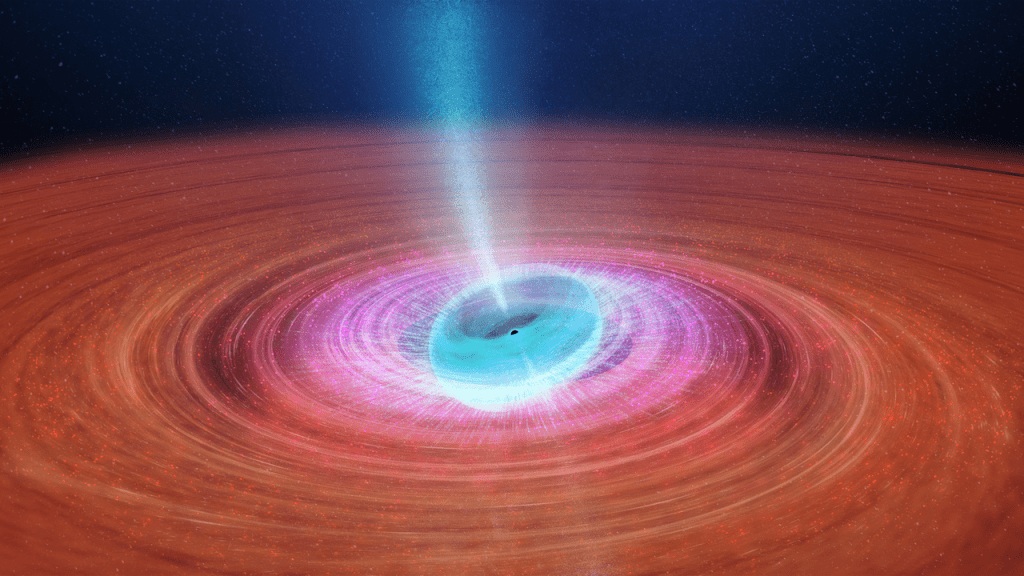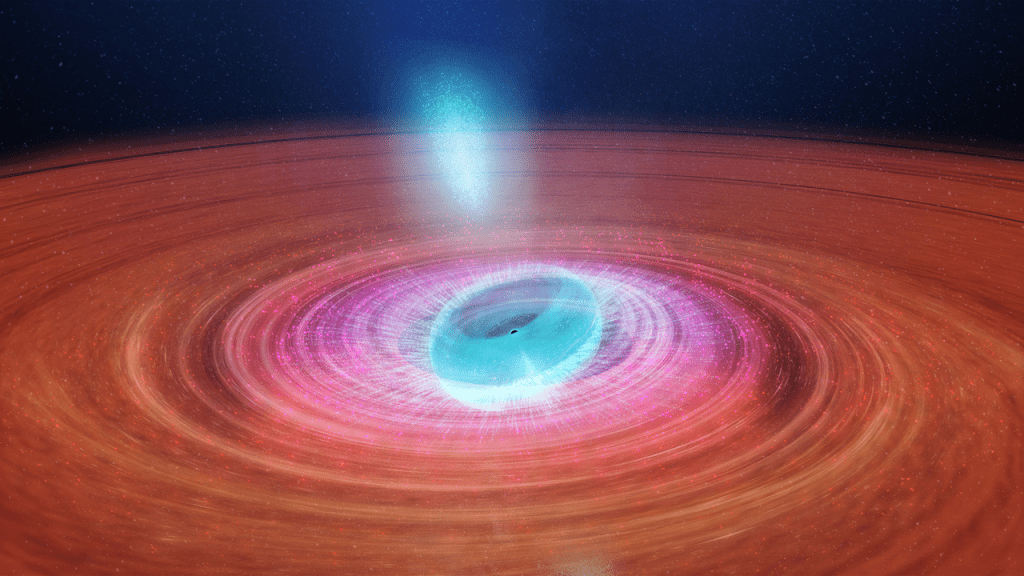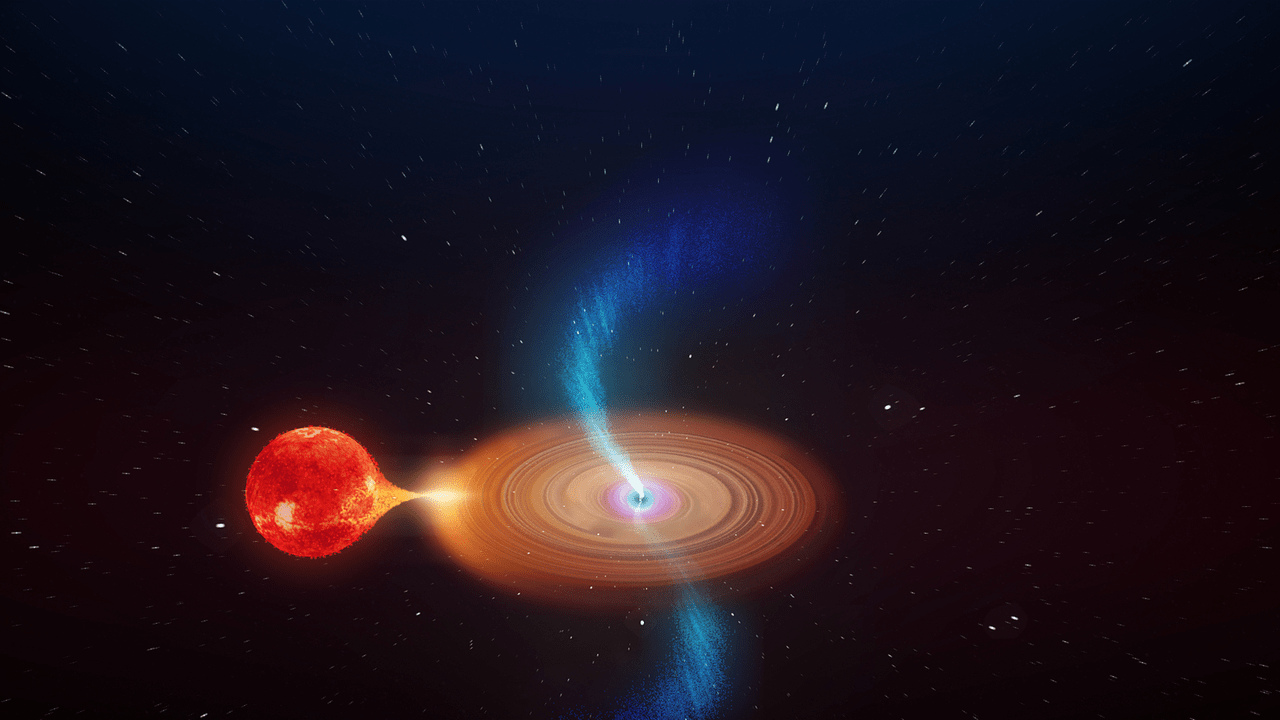Black holes, those beguiling singularities that sit on the precipice of the known and the unknown, keep surprising us with their behaviour. As organizations like the Event Horizon Telescope have made clear, there’s a lot we don’t know about the holes, and worse than that, we don’t even know how much we don’t know.
Now scientists have observed a new phenomenon that adds to the black hole mystique: a rapidly spinning black hole that ejects massive blobs of plasma.
The black hole in question is part of a binary pair called V404 Cygni. The black hole is eating its companion star, sucking its mass into its accretion disc, then ejecting material out via two jets. This is not unusual for a black hole, though not all of them have jets. But what is unusual is the timing of the material ejected by the jets. Rather than a steady stream, the material comes out in blobs.
V404 Cygni is about 8,000 light years away from Earth. It was first spotted in 1989 when it expelled an enormous outburst of high-energy material and radiation. Then it fell dormant for 26 years.
Then, in 2015, it flared up again, and the European Space Agency’s (ESA) INTEGRAL (INTErnational Gamma-Ray Astrophysics Laboratory) satellite was able to study it in high-energy gamma rays. It became the brightest object in the sky in gamma rays. At the time, INTEGRAL Project Scientist Erik Kuulkers said, “The behaviour of this source is extraordinary at the moment, with repeated bright flashes of light on time scales shorter than an hour, something rarely seen in other black hole systems.”
What was going on?
It’s useful to look at how black holes like this one usually work. The massive gravity of the black hole draws material away from its companion star into its accretion disk. The accretion disk spins, heating up the material and causing it to “shine.” Some of the material never reaches the black hole and is emitted via jets.

Fast forward to now, and a new study based on data gathered during the 2015 outburst by multiple observatories is providing an explanation.
“During the outburst we observed details of the jet emissions when material is ejected at a very high speed from the vicinity of the black hole,” says Simone Migliari, an astrophysicist at ESA who is a co-author on the paper. “We can see the jets shooting out in different directions on a timescale of less than an hour, which means that the inner regions of the system are rotating quite fast.”
Yes, the black hole is eating its companion star, sucking the material into its accretion disk. And yes, some of the material in the disk is expelled out in jets. But, according to the study, this only happens in bursts because for some reason, the black hole is misaligned with its own accretion disk.

“What’s different in V404 Cygni is that we think the disc of material and the black hole are misaligned,” says Associate Professor James Miller-Jones, from the International Centre for Radio Astronomy Research (ICRAR) at Curtin University, Australia, who is the lead author of the new paper.
“This appears to be causing the inner part of the disc to wobble like a spinning top that is slowing down, and fire jets out in different directions as it changes orientation.”
The wobbling means that material doesn’t fall into the black hole at an even rate. When there’s an outburst, it means a large amount of material has fallen into the hole in a short period of time. That increases the amount of material in the accretion disk causing an outburst of energy.

INTEGRAL was integral to this study because it watched V404 Cygni for four weeks. Other observatories were only able to watch for a few hours. INTEGRAL’s observations allowed scientists to figure out the mechanics of the black hole, its geometry and energy levels, and to make the link between inflowing and outflowing material.
“With INTEGRAL, we were able to keep looking at V404 Cygni continuously for four weeks, while other high-energy satellites could only take shorter snapshots,” says Erik Kuulkers, INTEGRAL Project Scientist at ESA.
“The X-ray data support a model where the inner part of the accretion disc is tilted with respect to the rest of the system, most likely due to the spin of the black hole being inclined with respect to the orbit of the companion star,” explains Simone.
The question remains, why is it misaligned?
There are only some preliminary guesses as to the cause of the misalignment. It may have been a supernova.
Since the black hole itself was created by a supernova, that initial kick may have caused the hole and interior segment of its accretion disk to be misaligned. That’s what simulations show, anyway.
“The results would fit in a scenario, also studied in recent computer simulations, where the accretion flow in the vicinity of the black hole and the jets can rotate together,” says Kuulkers.
“We should expect similar dynamics in any strongly-accreting black hole whose spin is misaligned with the inflowing gas, and we will have to take into account varying jet inclination angles when interpreting observations of black holes across the Universe.”
Sources:
- Research paper: A rapidly changing jet orientation in the stellar-mass black hole system VG404 Cygni
- Press Release: A Spitting Black Hole
- ESA’s INTEGRAL Mission
- Press Release: Monster Black Hole Wakes Up After 26 Years

